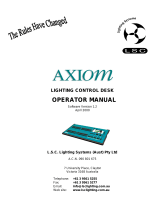
5
EUROLIGHT LC2412
7. ADDITIONAL FUNCTIONS OF THE LC2412 ............. 17
7.1 Locking program mode ............................................... 17
7.2 Putting the output on hold ........................................... 17
7.3 Special channels ......................................................... 17
7.4 Theater mode .............................................................. 17
7.4.1 Activating theater mode ................................... 17
7.4.2 Programming fading times in theater mode ...... 18
7.5 MIDI functions ............................................................. 18
7.5.1 Cascading two EUROLIGHT LC2412s ............. 18
7.6 Storing data on a memory card .................................. 18
7.7 Adjusting differing illumination levels ......................... 19
7.8 Erasing all settings/displaying software version ....... 19
8. DIMMER CONTROL .................................................. 19
8.1 Analog control ............................................................ 19
8.1.1 Controlling analog dimmers via DMX512 .......... 19
8.2 Digital control via DMX512 .......................................... 19
8.2.1 Digital control features ..................................... 19
8.2.2 Assigning DMX channels (softpatch) .............. 20
9. INSTALLATION ......................................................... 20
9.1 Cables recommended for DMX512 ............................ 21
9.2 Terminal resistor (bus termination) ............................. 21
9.3 Pin assignment ............................................................ 21
9.3.1 DMX512 connections ....................................... 21
9.3.2 Sub D connections (analog control) ................ 21
9.3.3 MIDI connection ................................................ 21
9.3.4 Audio connections ........................................... 21
9.3.5 Footswitch ....................................................... 21
9.4 Rack mounting ............................................................ 21
10. SPECIFICATIONS ................................................... 22
11. MIDI IMPLEMENTATION ......................................... 23
12. WARRANTY ............................................................ 24
1. INTRODUCTION
Thank you very much for the confidence you have placed in
us by purchasing the EUROLIGHT LC2412. You now own an
outstanding, ultra-compact light mixing console, that features
the state-of-the-art digital DMX512 control. In addition, your
LC2412 is equipped with an analog output which allows to use it
virtually in every environment you can think of. The design of the
LC2412 (how it operates and how it is programmed) was
constructed with controlling dimmer packs and standard
spotlights in mind. To optimally use multi-function spotlights such
as scanners and moving heads, you should use control
consoles specifically created for this purpose.
This users manual is designed to give you an overview of all
the controls, so that you get to know all possible applications the
LC2412 offers. General safety instructions are followed by a
structured overview of the control panel. Afterwards, all functions
of your LC2412 are described in detail.
Future-minded BEHRINGER technology
To allow for the highest possible level of operational safety,
we manufacture our equipment under the highest quality
standards in the industry.
Your LC2412 has been manufactured under ISO9000 certified
management system.
+ The following users manual is intended to
familiarize you with the units control elements,
so that you can master all the functions. After having
thoroughly read the users manual, store it at a safe
place for future reference.
1.1 Before you get started
1.1.1 Shipment
The LC2412 was carefully packed at the assembly plant to
assure secure transport. Should the condition of the cardboard
box suggest that damage may have taken place, please inspect
the unit immediately and look for physical indications of damage.
+ Damaged units should NEVER be sent directly to us.
Please inform the dealer from whom you acquired
the unit immediately as well as the transportation
company from which you took delivery of the unit.
Otherwise, all claims for replacement/repair may
be rendered invalid.
1.1.2 Initial operation
Please make sure the unit is provided with sufficient ventilation,
and never place the EUROLIGHT on top of an amplifier or in the
vicinity of a heater to avoid the risk of overheating.
+ Before plugging the unit into a power socket, please
make sure you have selected the correct voltage:
The fuse compartment near the power plug socket contains
three triangular markings. Two of these triangles are opposite
one another. The voltage indicated adjacent to these markings is
the voltage to which your unit has been set up, and can be
altered by rotating the fuse compartment by 180°. ATTENTION:
This does not apply to export models that were for
example manufactured only for use with 120 V!
+ If you alter the units voltage, you must change the
fuses accordingly. The correct value of the fuses
needed can be found in the chapter TECHNICAL
DATA.
+ Faulty fuses must be replaced with fuses of
appropriate rating without exception! The correct
value of the fuses needed can be found in the
chapter TECHNICAL DATA.
Power is delivered via the cable enclosed with the unit. All
requiered safety precautions have been adhered to.
+ Please make sure that the unit is grounded at all
times. For your own protection, you should never
tamper with the grounding of the cable or the unit
itself.
1.1.3 Warranty
Please take a few minutes and send us the completely filled
out warranty card within 14 days of the date of purchase. You
may also register online at www.behringer.com. The serial number
needed for the registration is located at the top of the unit. Failure
to register your product may void future warranty claims.
1.2 The users manual
The users manual is designed to give you both an overview of
the controls, as well as detailed information on how to use them.
In order to help you understand the links between the controls,
we have arranged them in groups according to their function. If
you need to know more about specific issues, please visit our
website at http://www.behringer.com.
1.3 General features and functions
LC2412 means: 24 preset channels and 12 memory channels.
But thats hardly all: You can simultaneously control 78 dimmer
channels via the DMX512 digital interface (26 console channels
x 3 DMX channels). And because several light units can be
operated on a single dimmer channel, this console gives you a
plethora of mixing possibilities.
1. INTRODUCTION





















